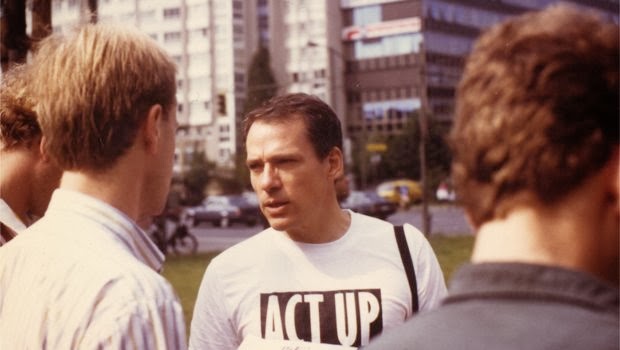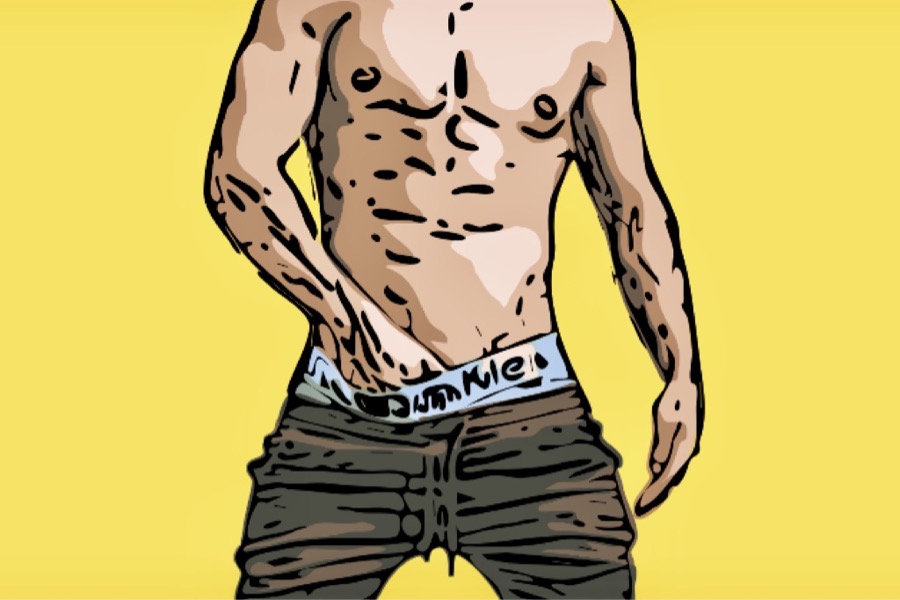The history and the pictures of gay life and safer sex campaigns since the HIV virus and AIDS came into the LGBTQ* movement are the matter of the new Bruno Gmünder’s book “Positive pictures“, which offers an interesting approach and a brilliant analysis. Il grande colibrì has interviewed Paul Schulz, deputy editor in chief of “Männer”, who wrote the book together with Christian Lütjens, co-editor in chief of “M+”, and publishes here even some pictures from the book.
It seems a little bit strange in 2013 to watch and read a book like yours. For a large part of the people in the Western world AIDS and HIVdon’t seem to be a main issue. When in the 1980s the virus was identified as a “gay problem”, the LGBT movement fought back, while at the moment the problem seems to be gone. What are the reasons of your book now, then?
 The initial reason for me to do the book was a deeply personal one. Two years ago, a young friend of mine became positive and was really scared about that. He speaks three languages fluently and I could not find a book in any of those languages that I could give him to take away his fear. Nothing had been written on the topic of HIV and AIDS in almost a decade that wasn’t for a more or less scientific readership or only about Safer Sex. I wanted to contextualize HIV for him, put it in perspective. So I decided that we would make the book that I needed ourselves and luckily, we found a publisher, Bruno Gmünder, who also wanted to do it.
The initial reason for me to do the book was a deeply personal one. Two years ago, a young friend of mine became positive and was really scared about that. He speaks three languages fluently and I could not find a book in any of those languages that I could give him to take away his fear. Nothing had been written on the topic of HIV and AIDS in almost a decade that wasn’t for a more or less scientific readership or only about Safer Sex. I wanted to contextualize HIV for him, put it in perspective. So I decided that we would make the book that I needed ourselves and luckily, we found a publisher, Bruno Gmünder, who also wanted to do it.
In the first stages of the research, my co-author Christian and I realized very quickly that the history of HIV is the history of the gay movement of the last 30 years in Europe and America and will probably stay a big part of our lives for a few decades to come. I wholeheartedly disagree with your assessment, that the problem is gone. It has just shifted from European and American cities to areas in Russia, Sub-Sahara Africa or India.
And what are in your opinion the reasons of this shift?
The reasons for its actual rise there are the same for its rise in Europe and America in the 1980s: there is no way to battle HIV successfully, without talking openly about gay sex and the way gay men live, because HIV is a gay issue. You have to support gay rights to be able to reach HIV-positive gay men and be able to teach them about safer sex. In countries where homosexuality is a problem, HIV is a problem among gay men. If you look at prevention as a universal thing to do, we have a long way to go. Anytime you fight homophobia anywhere in the world, you also fight against the virus. And the book, hopefully, is a tiny step in that direction. We need to be reminded now and then that gay men were and are heroes every day while fighting HIV and AIDS.
An important part of the book is dedicated to the “Generation safe sex”, explaining that the message “sex without a condom could be deadly” reached the people who were active in sex in that time, but in the same time the gay porn industry increased his specialization about fetishes and someone started to proclaim his “bareback pride”. What is similar and what is different in the present time?
What we mean with “Generation Safer Sex” is that there are two entire generations of gay men who experienced sex as something that could be potentially deadly when they came out, but developed ways to still have a lot of fun with each other sexually. “Positive Pictures” (and its authors) are completely pro sex and pro porn. Many guys in my generation – I’m 40 – learnt from porn how to use a condom and that Safer Sex can be great sex. People like porn director Chi Chi LaRue, who we interviewed for the book, are real heroes and saved thousands of lives, because they aggressively promoted condom use in their films.
But some labels and directors created their business with movies where condoms didn’t exist, sometimes with a clear mark: “bareback only”…
Bareback started out as something positive gay men did among them in private, because negative men would not sleep with them. The porn industry did not invent bareback. Today we have the problem that sex without a condom can be safer sex, if both partners are tested and negative, or even if one of them is positive and on a combination therapy, because these guys are not infectious. So what you see in a film and call “bareback” aka “dangerous” might actually be safer sex.
However, there is a big difference between porn actors, who have been tested for every STD known to men and know what they’re doing having sex without a condom on a controlled set, and the staff labels like “Treasure Island Media” use. To fetishize sperm or act like being HIV-positive is something desirable and promote drug use in porn is just stupid and can lead people to put themselves in danger. The simple answer is still: if you don’t know if your sexual partner is positive or negative and want to be as safe as possible, use a condom and don’t swallow. That hasn’t changed in 30 years. But the underlying reality of that statement is much more complex in 2013 than it was 20 years ago.
One theme seems to be almost missing in your pages. All the statistics indicate that AIDS and HIV are mostly a problem in the Us for black people and latinos, while in your book there are quite few pictures dedicated to this matter. Does it depend on the fact that campaigns themselves seems to be dedicated mostly to white people, or is it a choice due to the fact that the book is made in Europe and will be probably sold mainly to European people?
To say that HIV and AIDS are mainly a problem for blacks and latinos these days bucks me a little. The ideal community should be colorblind, because the virus is. The problem for blacks and latinos is a cultural one: many men in those cultures have a problem coming out as gay or bisexual, and because gay sex cannot be talked about openly, neither can safer sex. The Down-low phenomenon is only a symptom of a bigger underlying problem: the homophobia in those communities. But all that might change now that Frank Ocean and Jason Collins have come out. They are beacons and give me hope.
Talking of the book, it was for the aforementioned reasons difficult, to find artistic representations of black and latino men and HIV. “Positive Pictures” is a book about the visual representation of HIV by and through gay men. And that representation has been dominated by Caucasian faces for the last three decades and mainly taken place in the US and Europe. That might not be a politically correct thing to say, but it is the truth. And I can’t wait for that to change! Maybe we’ll get the chance to do a second edition in the future and I would love to include more black and latino men on every level.
Someone thinks that pre-exposure prophylaxis can be a good solution to prevent AIDS and HIV diffusion, while someone else objects that it lower one’s sense of responsibility. And what do you think about the debate about the use of pills even for HIV-negative people?
My personal position on PEP is a very simple one: how dare you use medication that could save a life in Africa to party and fuck around?! But the reality in the gay community, again, is more complex. I’m happy about every single person who stays negative. And if some of us need PEP to do that, give it to them. So, yes, I think PEP lowers one’s sense of responsibility, but, for those who realize they need it, it’s a responsible thing to do.
The book is full of colours and goes across more than thirty years through famous stars’ engagement. What are the perspective for the future of the safer sex campaigns?
Safer Sex campaigns rely less and less on stars or celebs and work with everyday gay men, who talk honestly about their desires and the sex they have or want to have, which is great! Because if we learnt one thing while writing and editing the book, it’s this: when it comes to safer sex, there are no better teachers for gay men than other gay men. In the future, stars will be used to collect money and promote equality, which people like Elizabeth Taylor, Sharon Stone or Elton John have done for decades and are incredibly successful at. But the conversation about safer sex will be had among gay men themselves, to whom it belongs.
Copyright©2013ilgrandecolibri.com







